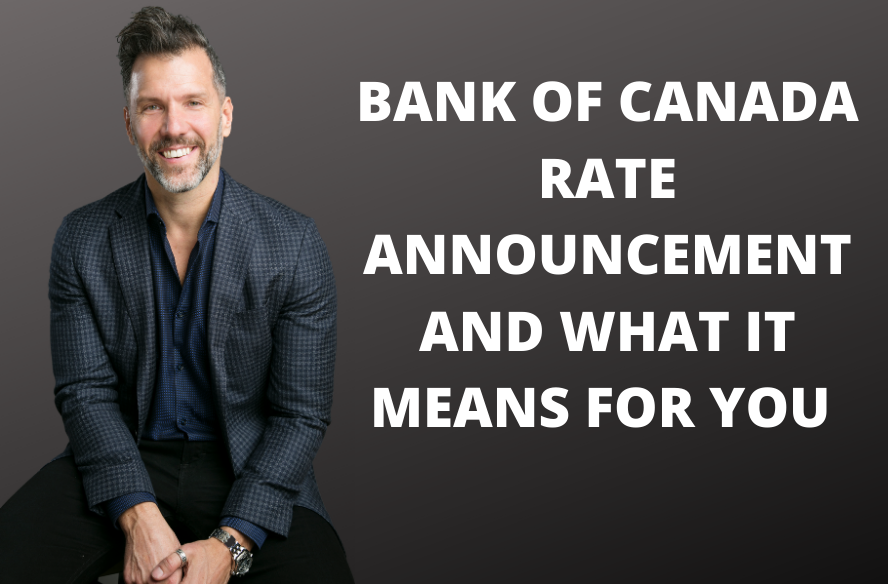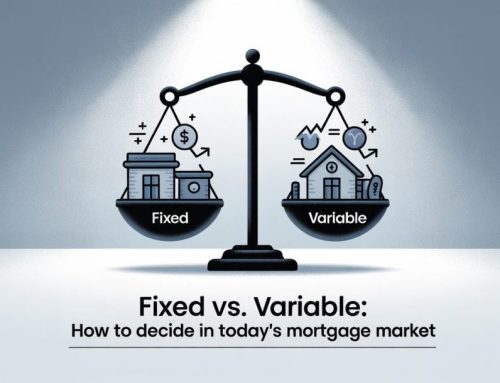The Bank of Canada announced this morning that they will be increasing their key policy rate by another 0.50%. This means that we can expect the prime rate to increase from 3.20% to 3.70%. I would expect the big banks to be the first to announce that they have matched the increase, followed by monoline lenders and credit unions. By the end of this week, all lenders will have made the adjustment.
Today’s rate increase is no surprise and is exactly what we were expecting. Anything different would have been shocking.
What Does This Mean For Fixed and Variable Rates?
These Bank of Canada rate announcements are primarily of interest to those with floating-rate loans such as variable rate mortgages and HELOCs (Home Equity Lines of Credit). This does not mean that fixed mortgage rates are increasing by the same margin. Fixed rates are largely influenced by bond yields, which can be affected by BOC rate movement.
They can be.
This doesn’t mean that they will be.
Fixed mortgage rates can remain flat, or even move in the opposite direction. It’s rare but it can happen. While further increases to fixed mortgage rates are likely, the pace at which they have been increasing has slowed considerably.
True Variable Rate Mortgages
When the Bank of Canada increases their rate, mortgage lenders will then adjust their prime rates accordingly. This means if you are currently in a variable rate mortgage then you will see your rate increase once your lender has made their adjustment to prime rate.
If you are in a true variable rate mortgage, then your payment will remain the same despite the increase in rate. What will change is the portion of the payment that is allocated to principal vs. interest. When the rate increases, the interest portion of your payment will increase while the principal portion decreases, but the payment always remains the same. This is common with the big banks.
While having a static payment can sound appealing, it could lead to frustration at the end of your term. For example, if you started with a 25 year amortization, then you could get to the end of your 5 year term and still have 23 or 24 years remaining. If rates were to continue to increase without any decreases along the way, then you could end up with a negative amortization. This is where your payment is not enough to cover all the interest, which means that you could have a longer effective amortization than what you had originally. This is an unlikely scenario, however.
Adjustable Rate Mortgages
Most ‘variable rate’ mortgages are actually adjustable-rate mortgages (ARMs). This is where the payment changes with the rate. For every 0.25% in rate increase, your payment can be expected to increase by roughly $12 for every $100,000 you owe on your mortgage. For example, if you owe $500,000 on your mortgage then today’s 0.50% increase will result in a payment increase of roughly $120.
The next scheduled rate announcement from the Bank of Canada will be on July 13th where I would expect them to increase their rate again. The question is whether they do another double increase of 0.50% or choose to stick with the standard increase of 0.25%. Time will tell.
The Inflation Problem
Inflation continues to be a problem which is why The Bank of Canada has been so aggressive with these rate increases. They are prepared to do whatever it takes to bring inflation down to their 2.00% target.
The biggest reason for the high inflation is a limited supply chain which is directly related to COVID. The Russian invasion of Ukraine has caused further restricted supply, which has added fuel to the inflation problem. While the Bank of Canada rate increases will not do anything to stimulate supply, they are intended to bring demand down to an equal level. This will have a significant negative impact on our economy which makes a forthcoming recession all but certain.
Once the Bank of Canada has reached their inflationary target, its focus will then shift to repairing the damaged economy. At this time, we can expect them to begin lowering their rate which is expected to happen at some point in 2024. This will also drive bond yields down, which would bring fixed mortgage rates back down with them.
Consumer Sentiment Worsening
The rapidly increasing mortgage rates are bringing down consumer sentiment, which is expected to decline further with continually increasing rates. This is more evidence that a recession is coming. The more aggressive the Bank of Canada gets, the faster sentiment will drop and the sooner we’ll go into a recession, which means the sooner they will need to begin cutting their rate.
Furthermore, Canadian debt levels remain at an all-time high, which intensifies the effect of each rate increase. This should mean that fewer rate increases from the BOC would be required. Regardless… they will continue with their rate hikes until inflation has been brought under control which is their number one priority.
A Goldmine Of Information To Answer Your Questions On Rising Rates
Mortgage rates are moving fast. But the faster they rise the sooner they will fall. This leads to multiple questions about what people should be doing with their mortgages, most of which I have answered in detail in my recent blogs:
How To Deal With Rising Mortgage Rates
Are Fixed Mortgage Rates Now The Way To Go?
How Many Rate Hikes Will It Take To Lose With A Variable Rate?
Why A Fixed Rate May Not Be The Best Choice
Should You Convert Your Variable Rate Into A Fixed?
Conclusion
The Bank of Canada has now increased their rate by 1.25% since March and is expected to increase by another 1.00% to 1.50% over the next year. This would bring the prime rate in the range of 4.20% to 4.70%.
Rising rates are always scary, but this is a rare time where they are somewhat predictable. It’s not just the further increases, but the recession-fueled decreases to follow. There has never been a five-year period where the Bank of Canada has increased their rate but not decreased it within the same year. It will happen, and there is plenty of evidence to support the expected rate decreases to come. It’s just a matter of when they start.
Circumstances can always change and anything can happen. We can only speculate based on what we know today.
Please leave any questions or comments below!








Leave A Comment